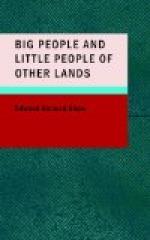PREFACE
This little book is designed to meet the child’s natural desire to learn or hear of other people than those living in the part of the world about him.
It has been thoroughly proved in our newer pedagogical practice that the child in the first school year is much interested in descriptions of the Indian and the Eskimo. Whenever descriptions of the Indian and the Eskimo have been given him, they have not only fulfilled their purpose in furnishing material for reading and the interrelation of several activities of expression, but they have revealed to him the fact that there are other people in the world, who differ very much from those he has seen.
His interest in different peoples at this time is in their physical appearance, their dress, their ways of living, their customs, their manners, and it arises chiefly from the contrast which descriptions of these afford to familiar customs, conditions, and physical characteristics.
The child is not interested, at that stage of his intellectual development which falls in the first or the second school year, in the situation of countries. It does not matter to him exactly where, geographically, the people about whom he reads live. He is satisfied if some general statement is made to the effect that they live far away to the north, where the cold countries are, or in the south, where it is warm and sometimes hot, or on the other side of the world.
His desire, at this period, for new impressions and ideas gained from descriptions and accompanying pictures is as keen as his desire for sense impressions gained from the world of nature and activity about him. This wider range of information and ideas, it is believed, he may in some measure gain from this little book.
Dresden, July 15, 1899.
PEOPLE OF OTHER LANDS.
CHINA.
On the other side of this great round world is a country called China. When it is dark here, and we are going to sleep, the sun is just waking up the children in China and telling them it is morning. When we get up in the morning they are just bidding the sun good night. When it is light here it is dark there. So they have day when we have night.
Chinese children look like little men and women, for they dress like their fathers and mothers. Boys and girls dress nearly alike. They both dress in silk or cotton trousers. They wear over these long gowns reaching nearly to their feet. They wear odd-looking shoes with thick white soles. The boys’ heads are shaved, except a small part on top. There a lock of hair is left. This lock of hair is braided and hangs down the back. A queer name is given to it. It is called a “queue.” Girls in China do not go to school, but all day long they are busy; they help their mothers keep house; they tend the babies; they sew, and help with the cooking.




